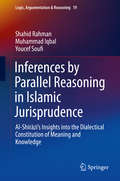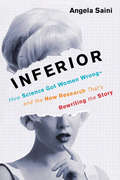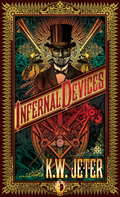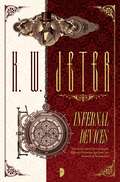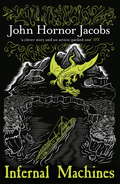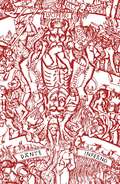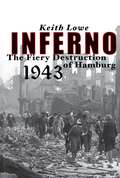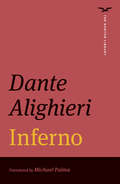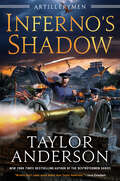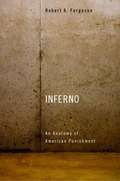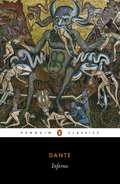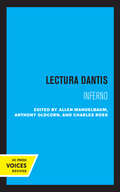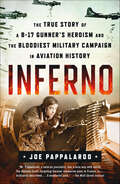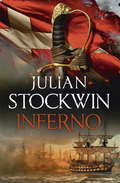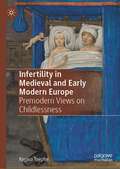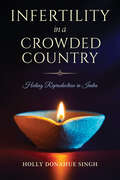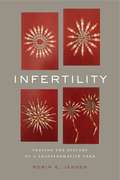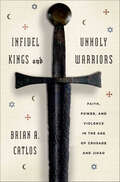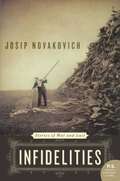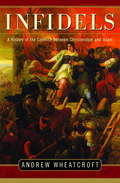- Table View
- List View
Inferences by Parallel Reasoning in Islamic Jurisprudence: Al-Shīrāzī’s Insights into the Dialectical Constitution of Meaning and Knowledge (Logic, Argumentation & Reasoning #19)
by Shahid Rahman Muhammad Iqbal Youcef SoufiThis monograph proposes a new (dialogical) way of studying the different forms of correlational inference, known in the Islamic jurisprudence as qiyās. According to the authors’ view, qiyās represents an innovative and sophisticated form of dialectical reasoning that not only provides new epistemological insights into legal argumentation in general (including legal reasoning in Common and Civil Law) but also furnishes a fine-grained pattern for parallel reasoning which can be deployed in a wide range of problem-solving contexts and does not seem to reduce to the standard forms of analogical reasoning studied in contemporary philosophy of science and argumentation theory. After an overview of the emergence of qiyās and of the work of al-Shīrāzī penned by Soufi Youcef, the authors discuss al-Shīrāzī’s classification of correlational inferences of the occasioning factor (qiyās al-'illa). The second part of the volume deliberates on the system of correlational inferences by indication and resemblance (qiyās al-dalāla, qiyās al-shabah). The third part develops the main theoretical background of the authors’ work, namely, the dialogical approach to Martin-Löf's Constructive Type Theory. The authors present this in a general form and independently of adaptations deployed in parts I and II. Part III also includes an appendix on the relevant notions of Constructive Type Theory, which has been extracted from an overview written by Ansten Klev. The book concludes with some brief remarks on contemporary approaches to analogy in Common and Civil Law and also to parallel reasoning in general.
Inferior: How Science Got Women Wrong-and the New Research That's Rewriting the Story
by Angela SainiWhat science has gotten so shamefully wrong about women, and the fight, by both female and male scientists, to rewrite what we thought we knewFor hundreds of years it was common sense: women were the inferior sex. Their bodies were weaker, their minds feebler, their role subservient. No less a scientist than Charles Darwin asserted that women were at a lower stage of evolution, and for decades, scientists—most of them male, of course—claimed to find evidence to support this.Whether looking at intelligence or emotion, cognition or behavior, science has continued to tell us that men and women are fundamentally different. Biologists claim that women are better suited to raising families or are, more gently, uniquely empathetic. Men, on the other hand, continue to be described as excelling at tasks that require logic, spatial reasoning, and motor skills. But a huge wave of research is now revealing an alternative version of what we thought we knew. The new woman revealed by this scientific data is as strong, strategic, and smart as anyone else.In Inferior, acclaimed science writer Angela Saini weaves together a fascinating—and sorely necessary—new science of women. As Saini takes readers on a journey to uncover science’s failure to understand women, she finds that we’re still living with the legacy of an establishment that’s just beginning to recover from centuries of entrenched exclusion and prejudice. Sexist assumptions are stubbornly persistent: even in recent years, researchers have insisted that women are choosy and monogamous while men are naturally promiscuous, or that the way men’s and women’s brains are wired confirms long-discredited gender stereotypes.As Saini reveals, however, groundbreaking research is finally rediscovering women’s bodies and minds. Inferior investigates the gender wars in biology, psychology, and anthropology, and delves into cutting-edge scientific studies to uncover a fascinating new portrait of women’s brains, bodies, and role in human evolution.
Infernal Devices
by K. W. JeterWHEN GEORGE'S FATHER DIED, HE LEFT GEORGE HIS WATCHMAKER SHOP - AND MORE. But George has little talent for watches and other infernal devices. When someone tries to steal an old device from the premises, George finds himself embroiled in a mystery of time travel, music and sexual intrigue. The classic steampunk tale from the master of the genre. With a new introduction by the author, and an afterword by Jeff VanderMeer.
Infernal Devices
by K. W. JeterThe classic Steampunk novel from the creator of the term itself – thirty years ago this month.When George Dower’s father died, he left George his watchmaker’s shop – and more. But George has little talent for watches and other infernal devices. When someone tries to steal an old device from the premises, George finds himself embroiled in a mystery of time travel, music and sexual intrigue.File Under: SteampunkFrom the Trade Paperback edition.
Infernal Devices
by Kw JeterWHEN GEORGE'S FATHER DIED, HE LEFT GEORGE HIS WATCHMAKER SHOP - AND MORE.But George has little talent for watches and other infernal devices. When someone tries to steal an old device from the premises, George finds himself embroiled in a mystery of time travel, music and sexual intrigue. The classic steampunk tale from the master of the genre.With a nw introduction by the author, and an afterword by Jeff VanderMeer.FILE UNDER: Steampunk [ Intriguing Tech | It's About Time | Musical Interlude | Classic Steampunk ]
Infernal Devices
by Kw JeterWHEN GEORGE'S FATHER DIED, HE LEFT GEORGE HIS WATCHMAKER SHOP - AND MORE.But George has little talent for watches and other infernal devices. When someone tries to steal an old device from the premises, George finds himself embroiled in a mystery of time travel, music and sexual intrigue. The classic steampunk tale from the master of the genre.With a nw introduction by the author, and an afterword by Jeff VanderMeer.FILE UNDER: Steampunk [ Intriguing Tech | It's About Time | Musical Interlude | Classic Steampunk ]
Infernal Machines
by John Hornor JacobsThe world is burning. Rume is under attck. The Autumn Lords, rulers of the Tchinee empire, have had their true nature revealed. The Emperor descends into madness. And Fisk and Shoe - unlikely heroes, very likely mercenaries - must find their way to Fisk's wife and child, who he has never seen.There might be quite a lot in their way. A war, for one thing. But Livia is as determined as Fisk to be reunited. And Shoe may have a plan...
Inferno
by DanteDiscover Dante's original Inferno in this modern and acclaimed Penguin translation. Describing Dante's descent into Hell with Virgil as a guide, Inferno depicts a cruel underworld in which desperate figures are condemned to eternal damnation for committing one or more of seven deadly sins. As he descends through nine concentric circles of increasingly agonising torture, Dante encounters many doomed souls before he is finally ready to meet the ultimate evil in the heart of Hell: Satan himself.This new edition of Inferno includes explanatory notes and an illustration of Dante's plan of hell. Robin Kirkpatrick's masterful translation is also available in a bilingual Penguin edition, with the original Italian on facing pages, and in a complete edition of The Divine Comedy with an introduction and other editorial materials. Dante Alighieri was born in 1265. He studied at the university of Bologna, married at the age of twenty and had four children. His first major work was La Vita Nuova (1292), a tribute to Beatrice Portinari, the great love of his life who had died two years earlier. In 1302, Dante's political activism resulted in his being exiled from Florence. After years of wandering, he settled in Ravenna and in about 1307 began writing The Divine Comedy. Dante died in 1321.Robin Kirkpatrick is a poet and widely-published Dante scholar. He has taught courses on Dante's Divine Comedy in Hong Kong, Dublin and Cambridge, where is Fellow of Robinson College and Professor of Italian and English Literatures.'The perfect balance of tightness and colloquialism...likely to be the best modern version of Dante' - Bernard O'Donoghue
Inferno
by Keith LoweIn the summer of 1943, British and American bombers launched an attack on the German city of Hamburg that was unlike anything the world had ever seen. For ten days they pounded the city with over 9,000 tons of bombs, with the intention of erasing it entirely from the map. The fires they created were so huge they burned for a month and were visible for 200 miles. The people of Hamburg had no time to understand what had hit them. As they emerged from their ruined cellars and air raid shelters, they were confronted with a unique vision of hell: a sea of flame that stretched to the horizon, the burned-out husks of fire engines that had tried to rescue them, roads that had become flaming rivers of melted tarmac. Even the canals were on fire. Worse still, they had to battle hurricane-force winds to escape the blaze. The only safe places were the city's parks, but to reach them survivors had to stumble through temperatures of up to 800°C and a blizzard of sparks strong enough to lift grown men off their feet. Inferno is the culmination of several years of research and the first comprehensive account of the Hamburg firestorm to be published in almost thirty years. Keith Lowe has interviewed eyewitnesses in Britain, Germany, and America, and gathered together hundreds of letters, diaries, firsthand accounts, and documents. His book gives the human side of an inhuman story: the long, tense buildup to the Allied attack; the unparalleled horror of the firestorm itself; and the terrible aftermath. The result is an epic story of devastation and survival, and a much-needed reminder of the human face of war. Includes nineteen maps and thirty-one photographs, many never seen before
Inferno (The Norton Library #0)
by Dante AlighieriAbout Michael Palma’s translation Michael Palma’s translation of the Inferno reproduces in contemporary English Dante’s intricate triple-rhyming terza rima form, defying the conventional wisdom of literary commentators who long argued that it simply cannot be done. This spectacular feat of poetic artistry— “accurate … admirably clear, and readable” (Richard Wilbur)—“in capturing the sense, sound, and spirit of the original … comes close to perfection” (X.J. Kennedy).
Inferno's Shadow (Artillerymen)
by Taylor AndersonLost in a mysterious world, far from all they knew in 1847 America, Colonel Lewis Cayce and his soldiers must face the unimaginable might of the Dominion once and for all in this gripping alternate history from the New York Times bestselling author of the Destroyermen series.Colonel Lewis Cayce and his forces were a group of American soldiers bound to fight in the Mexican-American War—until they were stranded in a strange new world inhabited by vicious monsters, new friends, and deadly foes. Now Cayce has brought his army of displaced Americans and their indigenous allies into the heart of the loathsome, blood-drenched Dominion&’s stronghold. If he can take the enemy&’s holiest city and support the elevation of a new &“Supreme Holiness&” who seeks to moderate the Dominion&’s thirst for expansion, slavery, and blood sacrifice, Cayce&’s own goal for his army and new people to live in security and freedom will be assured.But no matter how good of a soldier he is, Cayce is ruled by reason, and the madness and seemingly suicidal treachery of his adversaries, not to mention the sheer titanic scope of the force arrayed against him, might finally be more than he can cope with. Which side will ultimately discover that even victory can end in defeat?
Inferno: An Anatomy of American Punishment
by Robert A. FergusonAn Open Letters Monthly Best Nonfiction Book of the YearAmerica’s criminal justice system is broken. The United States punishes at a higher per capita rate than any other country in the world. In the last twenty years, incarceration rates have risen 500 percent. Sentences are harsh, prisons are overcrowded, life inside is dangerous, and rehabilitation programs are ineffective. Looking not only to court records but to works of philosophy, history, and literature for illumination, Robert Ferguson, a distinguished law professor, diagnoses all parts of a now massive, out-of-control punishment regime.“If I had won the $400 million Powerball lottery last week I swear I would have ordered a copy for every member of Congress, every judge in America, every prosecutor, and every state prison official and lawmaker who controls the life of even one of the millions of inmates who exist today, many in inhumane and deplorable conditions, in our nation’s prisons.”—Andrew Cohen, The Atlantic“Inferno is a passionate, wide-ranging effort to understand and challenge…our heavy reliance on imprisonment. It is an important book, especially for those (like me) who are inclined towards avoidance and tragic complacency…[Ferguson’s] book is too balanced and thoughtful to be disregarded.”—Robert F. Nagel, Weekly Standard
Inferno: Inferno
by DanteDescribing Dante's descent into Hell midway through his life with Virgil as a guide, Inferno depicts a cruel underworld in which desperate figures are condemned to eternal damnation for committing one or more of seven deadly sins. As he descends through nine concentric circles of increasingly agonising torture, Dante encounters doomed souls including the pagan Aeneas, the liar Odysseus, the suicide Cleopatra, and his own political enemies, damned for their deceit. Led by leering demons, the poet must ultimately journey with Virgil to the deepest level of all. For it is only by encountering Satan, in the heart of Hell, that he can truly understand the tragedy of sin.
Inferno: Lectura Dantis (Lectura Dantis #1)
by Allen Mandelbaum Anthony Oldcorn Charles RossThis title is part of UC Press's Voices Revived program, which commemorates University of California Press’s mission to seek out and cultivate the brightest minds and give them voice, reach, and impact. Drawing on a backlist dating to 1893, Voices Revived makes high-quality, peer-reviewed scholarship accessible once again using print-on-demand technology. This title was originally published in 1998.
Inferno: The Fiery Destruction of Hamburg 1943
by Keith LoweIn the summer of 1943, British and American bombers launched an attack on the German city of Hamburg that was unlike anything the world had ever seen. For ten days they pounded the city with over 9,000 tons of bombs, with the intention of erasing it entirely from the map. The fires they created were so huge they burned for a month and were visible for 200 miles. The people of Hamburg had no time to understand what had hit them. As they emerged from their ruined cellars and air raid shelters, they were confronted with a unique vision of hell: a sea of flame that stretched to the horizon, the burned-out husks of fire engines that had tried to rescue them, roads that had become flaming rivers of melted tarmac. Even the canals were on fire. Worse still, they had to battle hurricane-force winds to escape the blaze. The only safe places were the city's parks, but to reach them survivors had to stumble through temperatures of up to 800°C and a blizzard of sparks strong enough to lift grown men off their feet. Inferno is the culmination of several years of research and the first comprehensive account of the Hamburg firestorm to be published in almost thirty years. Keith Lowe has interviewed eyewitnesses in Britain, Germany, and America, and gathered together hundreds of letters, diaries, firsthand accounts, and documents. His book gives the human side of an inhuman story: the long, tense buildup to the Allied attack; the unparalleled horror of the firestorm itself; and the terrible aftermath. The result is an epic story of devastation and survival, and a much-needed reminder of the human face of war.
Inferno: The True Story of a B-17 Gunner's Heroism and the Bloodiest Military Campaign in Aviation History
by Joe PappalardoJoe Pappalardo's Inferno tells the true story of the men who flew the deadliest missions of World War II, and an unlikely hero who received the Medal of Honor in the midst of the bloodiest military campaign in aviation history.There’s no higher accolade in the U.S. military than the Medal of Honor, and 472 people received it for their action during World War II. But only one was demoted right after: Maynard Harrison Smith.Smith is one of the most unlikely heroes of the war, where he served in B-17s during the early days of the bombing of France and Germany from England. From his juvenile delinquent past in Michigan, through the war and during the decades after, Smith’s life seemed to be a series of very public missteps. The other airmen took to calling the 5-foot, 5-inch airman “Snuffy” after an unappealing movie character.This is also the man who, on a tragically mishandled mission over France on May 1, 1943, single-handedly saved the crewmen in his stricken B-17. With every other gunner injured or bailed out, Smith stood alone in the fuselage of a shattered, nameless bomber and fought fires, treated wounded crew and fought off fighters. His ordeal is part of a forgotten mission that aircrews came to call the May Day Massacre. The skies over Europe in 1943 were a charnel house for U.S. pilots, who were being led by tacticians surprised by the brutal effectiveness of German defenses. By May 1943 the combat losses among bomb crews were a staggering 40 to 50 percent.The backdrop of Smith’s story intersects with some of the luminaries of aviation history, including Curtis Lemay, Ira Eaker and “Hap” Arnold, during critical times of their storied careers. Inferno also examines Smith’s life in a new, comprehensive light, through the use of exclusive interviews of those who knew him (including fellow MOH recipients and family) as well as public and archival records. This is both a thrilling and horrifying story of the air war over Europe during WWII and a fascinating look at one of America's forgotten heroes.
Inferno: Thomas Kydd 17
by Julian Stockwin'In Stockwin's hands the sea story will continue to entrance readers across the world' - Guardian1807. Captain Sir Thomas Kydd's famous sea action aboard Tyger has snatched his reputation from ignominy. He is the hero of the hour. But though Britain's Navy remains imperious, a succession of battles has seen Napoleon victorious on mainland Europe. In an attempt to prevent the French from taking control of Denmark's navy, Kydd's great friend Nicholas Renzi - now Lord Farndon - is sent on a desperate diplomatic mission to persuade the Danes to give up their fleet to Britain. But the Danes are caught between two implacable forces and will not yield, opting instead for the inferno of battle . . .********************What readers are saying about INFERNO'An absolute must' - 5 stars'His books are always awesome, and Inferno is no exception' - 5 stars'As always, a great book' - 5 stars'Another great read in the series' - 5 stars'Another cracking read from an authoritative historical novelist' - 5 stars
Inferno: Thomas Kydd 17 (Thomas Kydd #17)
by Julian Stockwin'In Stockwin's hands the sea story will continue to entrance readers across the world' - Guardian1807. Captain Sir Thomas Kydd's famous sea action aboard Tyger has snatched his reputation from ignominy. He is the hero of the hour. But though Britain's Navy remains imperious, a succession of battles has seen Napoleon victorious on mainland Europe. In an attempt to prevent the French from taking control of Denmark's navy, Kydd's great friend Nicholas Renzi - now Lord Farndon - is sent on a desperate diplomatic mission to persuade the Danes to give up their fleet to Britain. But the Danes are caught between two implacable forces and will not yield, opting instead for the inferno of battle . . .********************What readers are saying about INFERNO'An absolute must' - 5 stars'His books are always awesome, and Inferno is no exception' - 5 stars'As always, a great book' - 5 stars'Another great read in the series' - 5 stars'Another cracking read from an authoritative historical novelist' - 5 stars
Inferno: Thomas Kydd 17 (Thomas Kydd #17)
by Julian StockwinUnputdownable naval action from the master of the sea story - 'In Stockwin's hands the sea story will continue to entrance readers across the world' Guardian1807. Captain Sir Thomas Kydd's famous sea action aboard Tyger has snatched his reputation from ignominy. He is the hero of the hour. But though Britain's Navy remains imperious, a succession of battles has seen Napoleon victorious on mainland Europe. In an attempt to prevent the French from taking control of Denmark's navy, Kydd's great friend Nicholas Renzi - now Lord Farndon - is sent on a desperate diplomatic mission to persuade the Danes to give up their fleet to Britain. But the Danes are caught between two implacable forces and will not yield, opting instead for the inferno of battle . . .(P) 2016 Hodder & Stoughton
Infertility in Medieval and Early Modern Europe: Premodern Views on Childlessness
by Regina ToepferThis book examines discourses around infertility and views of childlessness in medieval and early modern Europe. Whereas in our own time reproductive behaviour is regulated by demographic policy in the interest of upholding the intergenerational contract, premodern rulers strove to secure the succession to their thrones and preserve family heritage. Regardless of status, infertility could have drastic consequences, above all for women, and lead to social discrimination, expulsion, and divorce. Rather than outlining a history of discrimination against or the suffering of infertile couples, this book explores the mechanisms used to justify the unequal treatment of persons without children. Exploring views on childlessness across theology, medicine, law, demonology, and ethics, it undertakes a comprehensive examination of ‘fertility’ as an identity category from the perspective of new approaches in gender and intersectionality research. Shedding light on how premodern views have shaped understandings our own time, this book is highly relevant interest to students and scholars interested in discourses around infertility across history.
Infertility in a Crowded Country: Hiding Reproduction in India
by Holly Donahue SinghIn Lucknow, the capital of India's most populous state, the stigmas and colonial legacies surrounding sexual propriety and population growth affect how Muslim women, often in poverty, cope with infertility.In Infertility in a Crowded Country, Holly Donahue Singh draws on interviews, observation, and autoethnographic perspectives in local communities and Lucknow's infertility clinics to examine access to technology and treatments and to explore how pop culture shapes the reproductive paths of women and their supporters through clinical spaces, health camps, religious sites, and adoption agencies. Donahue Singh finds that women are willing to transgress social and religious boundaries to seek healing. By focusing on interpersonal connections, Infertility in a Crowded Country provides a fascinating starting point for discussions of family, kinship, and gender; the global politics of reproduction and reproductive technologies; and ideologies and social practices around creating families.
Infertility: Tracing the History of a Transformative Term (RSA Series in Transdisciplinary Rhetoric #3)
by Robin E. JensenThis book explores the arguments, appeals, and narratives that have defined the meaning of infertility in the modern history of the United States and Europe. Throughout the last century, the inability of women to conceive children has been explained by discrepant views: that women are individually culpable for their own reproductive health problems, or that they require the intervention of medical experts to correct abnormalities. Using doctor-patient correspondence, oral histories, and contemporaneous popular and scientific news coverage, Robin Jensen parses the often thin rhetorical divide between moralization and medicalization, revealing how dominating explanations for infertility have emerged from seemingly competing narratives. Her longitudinal account illustrates the ways in which old arguments and appeals do not disappear in the light of new information, but instead reemerge at subsequent, often seemingly disconnected moments to combine and contend with new assertions.Tracing the transformation of language surrounding infertility from “barrenness” to “(in)fertility,” this rhetorical analysis both explicates how language was and is used to establish the concept of infertility and shows the implications these rhetorical constructions continue to have for individuals and the societies in which they live.
Infidel Kings and Unholy Warriors: Faith, Power, and Violence in the Age of Crusade and Jihad
by Brian A. CatlosAn in-depth portrait of the Crusades-era Mediterranean world, and a new understanding of the forces that shaped itIn Infidel Kings and Unholy Warriors, the award-winning scholar Brian Catlos puts us on the ground in the Mediterranean world of 1050–1200. We experience the sights and sounds of the region just as enlightened Islamic empires and primitive Christendom began to contest it. We learn about the siege tactics, theological disputes, and poetry of this enthralling time. And we see that people of different faiths coexisted far more frequently than we are commonly told. Catlos's meticulous reconstruction of the era allows him to stunningly overturn our most basic assumption about it: that it was defined by religious extremism. He brings to light many figures who were accepted as rulers by their ostensible foes. Samuel B. Naghrilla, a self-proclaimed Jewish messiah, became the force behind Muslim Granada. Bahram Pahlavuni, an Armenian Christian, wielded power in an Islamic caliphate. And Philip of Mahdia, a Muslim eunuch, rose to admiral in the service of Roger II, the Christian "King of Africa." What their lives reveal is that, then as now, politics were driven by a mix of self-interest, personality, and ideology. Catlos draws a similar lesson from his stirring chapters on the early Crusades, arguing that the notions of crusade and jihad were not causes of war but justifications. He imparts a crucial insight: the violence of the past cannot be blamed primarily on religion.
Infidelities: Stories of War and Lust
by Josip NovakovichTragicomedy of the highest order, this stellar collection is Croatian writer Novakovich's best ever. Hailed as one of the best short story writers of the 1990s, Josip Novakovich was praised by the New York Times for writing fiction that has "the crackle of authenticity, like the bite of breaking glass." In his new collection, he explores a war–torn Balkan world in which a schoolchild's innocence evaporates in a puff of cannon smoke, lust replaces love, and the joy of survival overrides all other pleasures. As Serb, Croat, and Bosnian Muslim armies clash in the cities and countryside of the former Yugoslavia, it's hard to tell the front lines from the home front. The characters in Infidelities––soldiers and civilians alike––are caught in the ridiculous, often cruelly whimsical contradictions of war and the paranoia and folly of those who conduct it. In "Ribs," a Croatian woman whose husband has already been taken by the war will go to any length to keep her son out of the army, including sleeping with the draft officer, a tryst that leads to an unexpected, and disturbing, spiritual vision. A Buddhist soldier in the Bosnian Muslim military isly accused of being an informer to the enemy Serbs after his detachment ambushes itself in "Hail." A draft dodger is in the hospital for a transplant, in "A Purple Heart," when a high–ranking Croatian general steals the heart for himself (and dies) while the dodger suddenly discovers a new thirst for life. In "Spleen," a Bosnian émigré in America learns that even in the throes of passion she cannot find release from the haunting memories of her homeland. These stories cover a broad sweep of time, reaching back to the first shots of World War I in Sarajevo and forward to the plight of Balkan immigrants in contemporary America. Throughout, acts of compassion, gallows humour, even desire arise from a landscape devastated by tragedy.
Infidels: A History of the Conflict Between Christendom and Islam
by Andrew WheatcroftHere is the first panoptic history of the long struggle between the Christian West and Islam.<P> In this dazzlingly written, acutely nuanced account, Andrew Wheatcroft tracks a deep fault line of animosity between civilizations. He begins with a stunning account of the Battle of Lepanto in 1571, then turns to the main zones of conflict: Spain, from which the descendants of the Moors were eventually expelled; the Middle East, where Crusaders and Muslims clashed for years; and the Balkans, where distant memories spurred atrocities even into the twentieth century. Throughout, Wheatcroft delves beneath stereotypes, looking incisively at how images, ideas, language, and technology (from the printing press to the Internet), as well as politics, religion, and conquest, have allowed each side to demonize the other, revive old grievances, and fuel across centuries a seemingly unquenchable enmity. Finally, Wheatcroft tells how this fraught history led to our present maelstrom. We cannot, he argues, come to terms with today's perplexing animosities without confronting this dark past.
